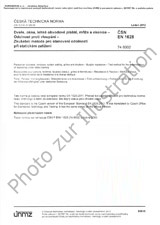Wir benötigen Ihre Einwilligung zur Verwendung der einzelnen Daten, damit Sie unter anderem Informationen zu Ihren Interessen einsehen können. Klicken Sie auf "OK", um Ihre Zustimmung zu erteilen.
ČSN EN ISO 19901-10 (450027)
Petroleum and natural gas industries - Specific requirements for offshore structures - Part 10: Marine geophysical investigations
Name übersetzen
NORM herausgegeben am 1.8.2022
Informationen über die Norm:
Bezeichnung normen: ČSN EN ISO 19901-10
Zeichen: 450027
Katalog-Nummer: 514777
Ausgabedatum normen: 1.8.2022
SKU: NS-1067972
Zahl der Seiten: 96
Gewicht ca.: 319 g (0.70 Pfund)
Land: Tschechische technische Norm
Kategorie: Technische Normen ČSN
Kategorie - ähnliche Normen:
Die Annotation des Normtextes ČSN EN ISO 19901-10 (450027):
This document provides requirements and guidelines for marine geophysical investigations. It is applicable to operators/end users, contractors and public and regulatory authorities concerned with marine site investigations for offshore structures for petroleum and natural gas industries.
This document provides requirements, specifications, and guidance for:
- a) objectives, planning, and quality management;
- b) positioning;
- c) seafloor mapping, including instrumentation and acquisition parameters, acquisition methods, and deliverables;
- d) sub-seafloor mapping, including seismic instrumentation and acquisition parameters, and non-seismic-reflection methods;
- e) reporting;
- f) data integration, interpretation, and investigation of geohazards.
This document is applicable to investigation of the seafloor and the sub-seafloor, from shallow coastal waters to water depths of 3 000 m and more. It provides guidance for the integration of the results from marine soil investigations and marine geophysical investigations with other relevant datasets.
NOTE 1 - The depth of interest for sub-seafloor mapping depends on the objectives of the investigation. For offshore construction, the depths of investigation are typically in the range 1 m below seafloor to 200 m below seafloor. Some methods for sub-seafloor mapping can also achieve much greater investigation depths, for example for assessing geohazards for hydrocarbon well drilling.
There is a fundamental difference between seafloor mapping and sub-seafloor mapping: seafloor signal resolution can be specified, while sub-seafloor signal resolution and penetration cannot. This document therefore contains requirements for the use of certain techniques for certain types of seafloor mapping and sub-seafloor mapping (similarly, requirements are given for certain aspects of data processing). If other techniques can be shown to obtain the same information, with the same or better resolution and accuracy, then those techniques may be used.
Mapping of pre-drilling well-site geohazards beneath the seafloor is part of the scope of this document.
NOTE 2 - This implies depths of investigation that are typically 200 m below the first pressure-containment casing string or 1 000 m below the seafloor, whichever is greatest. Mapping of pre-drilling well-site geohazards is therefore the deepest type of investigation covered by this document.
In this document, positioning information relates only to the positioning of survey platforms, sources and receivers. The processes used to determine positions of seafloor and sub-seafloor data points are not covered in this document.
Guidance only is given in this document for the use of marine shear waves (A.8.3.3), marine surface waves (A.8.3.4), electrical resistivity imaging (A.8.3.5) and electromagnetic imaging (A.8.3.6)
Normansicht ČSN EN ISO 19901-10 (450027)
Empfehlungen:
Aktualisierung der technischen Normen
Wollen Sie sich sicher sein, dass Sie nur die gültigen technischen Normen verwenden?
Wir bieten Ihnen eine Lösung, die Ihnen eine Monatsübersicht über die Aktualität der von Ihnen angewandten Normen sicher stellt.
Brauchen Sie mehr Informationen? Sehen Sie sich diese Seite an.




 Cookies
Cookies
